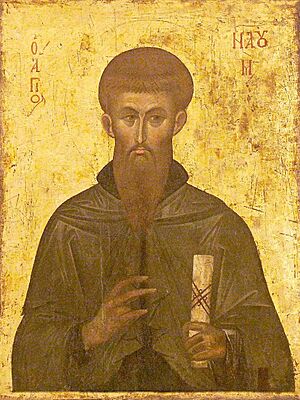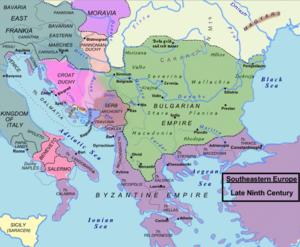Saint Naum facts for kids
Quick facts for kids SaintNaum |
|
|---|---|

Icon of Saint Naum
|
|
| Wonderworker, Apostle of the Slavs | |
| Born | c. 830 Moesia, First Bulgarian Empire |
| Died | December 23, 910 Ohrid, First Bulgarian Empire, (present-day North Macedonia) |
| Venerated in | Eastern Orthodox Church, Eastern Catholic Churches, Latin Church |
| Major shrine | Monastery of Saint Naum in Ohrid (Sveti Naum) |
| Feast | 5 January and 3 July (Julian calendar), 20 May and 23 December (Revised Julian calendar, Gregorian calendar) |
Naum (also known as Naum of Ohrid or Naum of Preslav) was an important writer and missionary. He lived from about 830 to December 23, 910. Naum helped spread Christianity among the Slavs, who were people living in Eastern Europe.
He was one of the Seven Apostles of the First Bulgarian Empire. Naum was a student of Cyril and Methodius, who created the Glagolitic and Cyrillic script. These alphabets helped people write in Slavic languages. Naum also helped start important schools in Bulgaria.
Naum's Life Story
We do not know much about Naum's early life. He grew up in a place called Moesia, which was part of Bulgaria. Naum joined Cyril and Methodius and other missionaries in 863. They went on an important mission to Great Moravia.
Work in Great Moravia
For 22 years, Naum worked with Cyril and Methodius. They translated the Bible into Old Church Slavonic. This was an early form of the Slavic language. They also taught people in Great Moravia and a place called Lower Pannonia.
In 867 or 868, Naum became a priest in Rome. He was ordained with two other students, Gorazd and Clement. For their mission, they created the Glagolitic alphabet. This was the first alphabet made for the Slavic language. The Cyrillic script, which many languages still use today, came from Glagolitic.
The missionaries also wrote the first Slavic Civil Code. This was a set of laws used in Great Moravia. However, some German church leaders did not like their work. They did not want services to be held in the Slavic language. By 885, the leaders who supported the missionaries had died. The pressure from the German Church grew stronger. Naum and other missionaries were even put in prison for a short time. After this, Naum, Clement, and Angelar went to Bulgaria.
In the First Bulgarian Empire
In 886, the ruler of Belgrade, which was then in Bulgaria, welcomed the missionaries. Bulgaria was led by Knyaz Boris, who had become a Christian in 864. Before this, church services in Bulgaria were in Greek. Boris worried about too much influence from the Byzantine Empire. He thought using Old Church Slavonic would help Bulgaria stay independent.
So, Boris set up two special schools. These schools would teach about religion in the Slavonic language. The first school was in the capital city, Pliska. The second school was in Ohrid. Learning to read and write in Old Church Slavonic helped Bulgarians keep their own culture.
Naum first went to the capital, Pliska. He worked at the Pliska Literary School from 886 to 893. He was one of its founders. A famous writing from that time, "An Account of Letters," called for a common Slavic alphabet.
In 893, the new ruler, Simeon the Great, held a meeting. Clement was made a bishop in Ohrid. To take Clement's place in Ohrid, Simeon sent Naum. Naum continued Clement's important work at the Ohrid Literary School. During these years, the Cyrillic script was created. It was adopted in Bulgaria, possibly because Naum suggested it.
In 905, Naum started a monastery on the shores of Lake Ohrid. This monastery was later named after him. He died there in 910. Clement then began the process to make Naum a saint. This made Naum the first "native" saint of Bulgaria.
Naum's Legacy
People especially honored Saint Naum in the Ohrid area. His fame grew in the 1700s. His name became known in other places like Mount Athos and Vienna. Even members of the Bektashi order visited his monastery. They believed their own saint, Sarı Saltık, was buried there. Saint Naum's original feast day was December 23. Later, it was changed to June 20.
St. Naum Peak on Livingston Island in Antarctica is named after Saint Naum.



